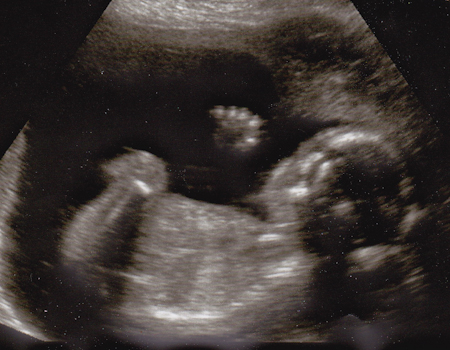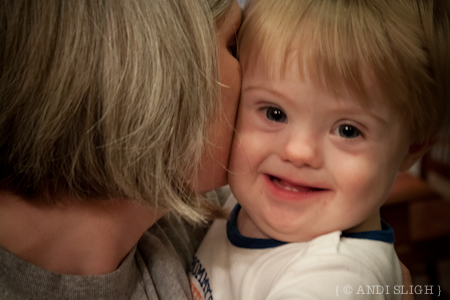Reports place the Down syndrome abortion rate (i.e., the termination of babies diagnosed in utero with trisomy 21) at between 85-92%, as I’ve mentioned before. A key takeaway, though, is “diagnosed in utero.” While that 9 out of 10 statistic is jaw-droppingly horrifying, it’s only part of the story.
Until the 2011 release of MaterniT21, the maternal blood test for Down syndrome, the only prenatal diagnostic test options for Down syndrome were amniocentesis and chorionic villus sampling (CVS), and only 2-3% of women pursued amnio or CVS. The actual rate of termination of all babies conceived with Down syndrome (diagnosed or undiagnosed) is about 50% (both the IDSC for Life and Amy Julia Becker have researched and published the available information recently).
Now, I don’t know if you’re a glass-half-full kind of person or a glass-half-empty kind of person – I tend to go back and forth depending on the day, the subject matter, or my general outlook at the time. It’s easy to see the elimination of half of Nathan’s peer community as a bad thing (and of course, it is), but there’s some good news, too.
Half of the Down syndrome community is still with us.
Many of these individuals were protected by parents who declined prenatal tests because they were resolved to love their child no matter what. Other parents faced the cold, hard reality of the T21 karyotype illustrated in black and white under the fluorescent lights of a geneticist’s office, but, when offered an abortion, declined. But other individuals with T21 arrived unexpectedly, after keeping secret their unique quality from the doctors and their parents who would have wanted their termination.
Whatever the circumstances that allowed them to join our number, these special people and their families are living among us.
Children with Down syndrome in this country are no longer hidden away in institutions. They aren’t segregated in basement classrooms. They play sports, are recognized by their peers and work in highly visible locations. Our family (we live in Mayberry, not a major metro area) met two such individuals recently at our beach-less-traveled, and others at the local seafood dive, at a swim meet, and at Publix Supermarket, just to name a few. At each of these meetings, I learned a little more about future possibilities and shared a little more about what makes our lives special and beautiful. I’ve become acquainted with countless others online – some who blog like I do, while others comment or email me here.
The number of individuals with T21 may have shrunk, but they’re more visible now than ever.
The family and friends of people with Down syndrome are ready, willing, and able to support the new families joining our numbers each and every day. We are prepared to fight alongside them, pat them on the back, dry their tears, laugh with them, and be their friends: we only need to have the door opened to us.
We are welcomed in when a baby with trisomy 21 is born – in the days of uncertainty and fear before parents resolve to stop crying and do what needs to be done to care for their child. But the days before the birth may be the ones when we are most needed – the days before parents make a decision to abort, based largely on fear and outdated information, that they may regret for the rest of their lives.
MaterniT21 (and others) promises a diagnostic test at an earlier stage of pregnancy. Many have expressed concerns that easier, earlier testing will lead to more abortions of individuals with Down syndrome, because many women will not yet be “showing” and can obtain a quiet abortion – even before their partner is aware of the pregnancy. There’s another option, though, that I hope comes to fruition (and given that the percentage of “pro-choice” Americans has reached a record low, I think it’s a definite possibility).
With more time to research Down syndrome, more women may have the opportunity to discover blogs like this one (or this one or this one or yes, even this one) that positively portray real life with a child with Down syndrome.
Maybe our modern day tendency toward cyberchondria will lead people to gather REAL information about REAL families, rather than relying on physicians who know what’s in the textbooks but don’t know what it’s like to love someone with Down syndrome.
Maybe those who pressed for early diagnostic tests will discover one day soon that their zeal to identify and “eradicate” Down syndrome had unintended consequences: more parents learned the truth, and made the decision, without pressure, to love and care for the child God gave them.
This post is part two of a two-part series on prenatal testing. Part one, A Tale of Two Babies, was published on June 13.





This is great. I love seeing a positive spin on the topic. Thanks for giving a glass half full perspective. (Or at least, allowing me to look at it that way!)
We join you in that fight! Thanks for this great article.
Love your perspective here.
Just to be devil’s advocate, lets think about the other side of this. If a mother chooses not to abort a baby diagnosed with T21, does she do it for the life of the child? Does she keep the child for its well being, because it will have a high quality of living? Or because SHE will feel bad? because SHE feels the need to do the “right thing”? Because “God” gave you the child?
My question is whether or not keeping a baby is a selfish act. Before you immediately scoff at that comment, take a moment to think outside of the box. You are obviously a smart person who is well educated and well respected. If you had to take the other side of your argument, how would you defend it?
The right thing to do is still the right thing to do, regardless of whether the individual’s motivations are pure. I take my children to school in the mornings – it’s the right thing to do because it’s the method we’ve chosen for them to receive an education. Does the fact that I look forward to having a few hours at home alone to clean the house, write a few blog posts, or simply have a cup of coffee in silence make the fact that I took them to school a selfish act?
Those things are for you, so I suppose they are selfish. But that’s where the lines blur on what “selfish” actually is.
Like I said, I don’t disagree with you, I just like to make people think outside the box a bit. You sound like a great mother and your blog is great. What you’re doing for others brings them a lot of hope. I wish you the best. You set an example for humanity and remind all of us just how good humans can be. <3
Thanks, Aaron! I spend a lot of time thinking and pondering and processing. I think the real question goes back to how squishy moral judgments have become in our society. Few people are willing to step up and call specific actions right or wrong anymore. I’m not discounting the motivations that drive people, of course, because actions don’t exist in a vacuum. But it seems to me that we’ve become so focused on the Why that we often skip right over the What.
And I believe you may have inspired a new blog post… 🙂